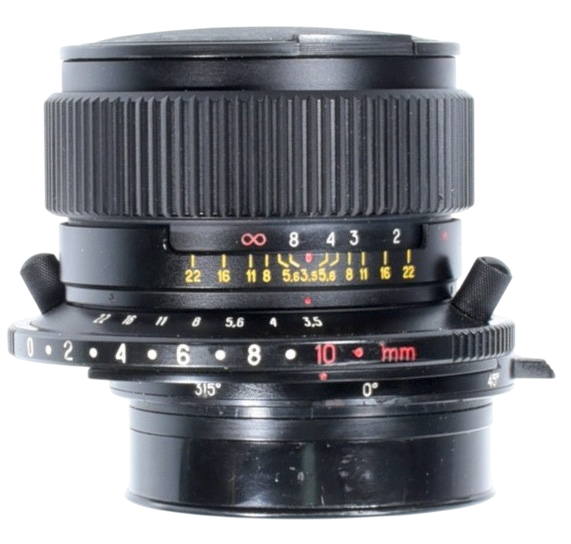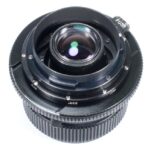Hartblei 65mm F/3.5 PCS MC
Shift lens • Film era • Discontinued • Collectible
Abbreviations
| MC | Multi-layer anti-reflection coating is applied to the surfaces of lens elements. This anti-reflection coating increases light transmission, eliminates flare and ghosting, and maintains color consistence among all lens models. |
Model history (3)
| ■Hartblei 65mm F/3.5 PCS MC | M | 6 - 5 | 0.50m | ⌀72 | ● | |
| ■Hartblei 65mm F/3.5 TS-PC MC | M | 6 - 5 | 0.50m | ⌀72 | ● | |
| ■Hartblei Super-Rotator 65mm F/3.5 TS-PC MC | M | 6 - 5 | 0.45m | ⌀72 | ● | |
Specification
| Optical design: | |
| Medium format 6x6 | |
| 65mm | |
| F/3.5 | |
| 6 elements in 5 groups | |
| Contax 645 [64mm] | |
| Mamiya M645 [63mm] | |
| Pentax 645 [70.87mm] | |
| Praktisix (Pentacon Six) [74mm] | |
| 56.4° | |
| 56.4° | |
| 56.4° (Medium format) | |
| 45.7° (Medium format, cropped frame) | |
| 62.3° | |
| Diaphragm mechanism: | |
Diaphragm type: | Manual |
Aperture control: | Aperture ring |
| <No data> | |
| Focusing: | |
| 0.50m | |
| <No data> | |
Focusing modes: | Manual focus only |
Manual focus control: | Focusing ring |
| Perspective control mechanism: | |
Shift range: | 0..+10mm |
Tilt range: | Not available |
| Yes | |
| - | |
| Physical characteristics: | |
| 650g (Praktisix (Pentacon Six)) | |
| ⌀96×90mm (Praktisix (Pentacon Six)) | |
| Accessories: | |
| Screw-type 72mm | |
| <No data> | |
| <No data> |
Source of data
- Manufacturer's technical data.
Manufacturer description
The MC PCS Hartblei 3.5/65 lens (MC for multilayer coating, PCS for perspective correction by shift) is a wide-angle six-lens optical system ensuring high-quality shots of architecture ensembles, landscapes and sport events. This lens is indispensable for tight-space photographing.
The lens has a Pentacon Six bayonet type mount which allows to use this lens with Pentacon Six, Exakta 66, Hartblei 1006/456/66 and Kiev 688/60 cameras.
The lens has a film-parallel optic block shift mechanism giving the user a unique possibility to compensate for image distortions when photographing architecture ensembles and taking panoramic pictures.
The optical parts of the lens have a special multilayer coating for better picture quality and contrast through greater integral transmission and lower dispersion.
SHIFTING THE LENS
Shift the lens by rotating the shift scale ring.
Set shift direction by rotating the lens about the bayonet mount axis.
To rotate the lens, pull the retainer key toward the camera. The lens can be rotated 360° about the bayonet mount axis and fixed with 15-degree intervals.
COMPENSATING FOR IMAGE DISTORTIONS
When you take a picture of a high building from the ground, its top and bottom are at different distances from the lens. The resulting distortion is a pyramid look of the building, and if you take the picture from above, the building will look like a turned pyramid. To compensate for such distortions, do not tilt the camera up or down; instead, keep the film surface parallel to the photographed object (in this case, the building) so that the back side of your camera is perpendicular to the ground. Then shift the optical block vertically upward, which will eliminate the distortion.
Sometimes distortions are desired in order to create special effects. To achieve such a distortion, tilt the camera upward and shift the lens downward.
ELIMINATING REFLECTIONS
Pictures of objects with reflecting surfaces may have reflections of the photographer with the camera. To eliminate the reflection while keeping the picture rectangular, shift the camera angle to one side and the lens to the other. The film and object surfaces will remain parallel.
TAKING PANORAMIC PHOTOGRAPHS
PCS lenses can be used for panoramic photography. Take two pictures from the same camera angle: one with maximum lens shift to the right, the other with maximum shift to the left. When combined during printing, the two frames will produce a single panoramic picture corresponding to a 6x9-cm normal-perspective negative. Vertical panoramic photography is also possible.
ELIMINATING INTERFERENCES
By shifting the lens and turning the camera you can eliminate interferences such as trees and telegraph poles close to the camera and appearing on the frame edge.
Let's suppose that you have interference from the right. To eliminate it, shift the lens to the right and turn the camera to the left until the interference disappears.
From the editor
A shift lens based on the Mir-38 and a shift adapter. Sold by the Hartblei company (Kiev/Munich).
Lenses with similar focal length
| ■Praktisix (Pentacon Six) mount (1) | |||||||||
| Arsat 65mm F/3.5 PCS MC | M | 6 - 5 | 0.50m | ⌀72 | ● | ||||
| ■Contax 645 mount (1) | |||||||||
| Hartblei 65mm F/3.5 TS-PC MC | M | 6 - 5 | 0.50m | ⌀72 | ● | ||||
| ■Mamiya M645 mount (1) | |||||||||
| Hartblei 65mm F/3.5 TS-PC MC | M | 6 - 5 | 0.50m | ⌀72 | ● | ||||
| ■Pentax 645 mount (1) | |||||||||
| Hartblei 65mm F/3.5 TS-PC MC | M | 6 - 5 | 0.50m | ⌀72 | ● | ||||


